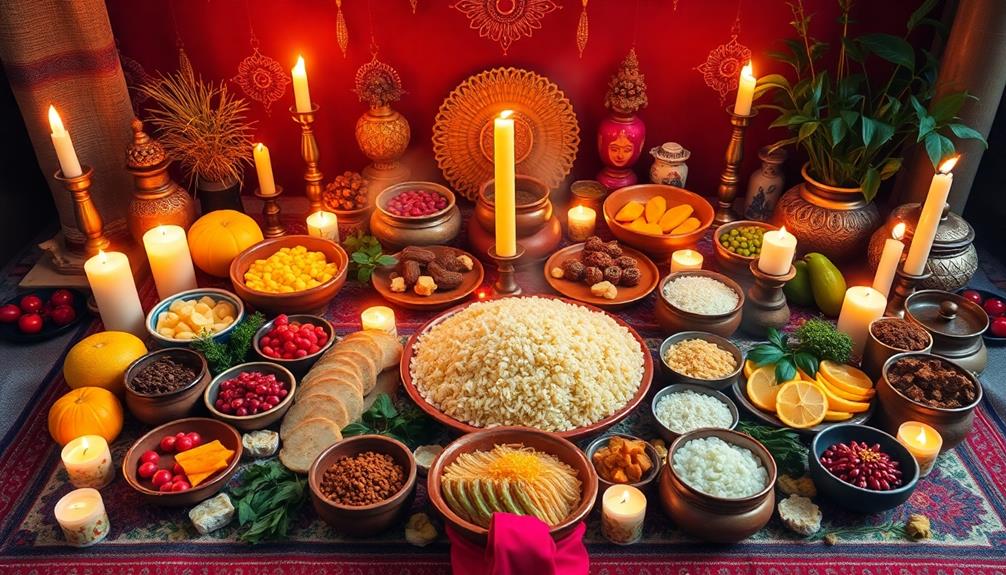Certain foods are considered sacred in various traditions because they hold deep cultural meanings and symbolize important historical events or spiritual beliefs. For instance, matzah in Jewish culture represents freedom, while bread and wine in Christianity signify unity with Christ. These foods often enhance communal bonds, linking individuals to their heritage and ancestors during rituals. They serve as powerful symbols of identity, gratitude, and shared experience. By participating in the rituals surrounding sacred foods, you connect more deeply with your culture. If you look closer, you'll find even more fascinating layers to these culinary traditions.
Key Takeaways
- Sacred foods symbolize cultural identity, connecting individuals to their heritage and reflecting societal values and beliefs.
- Rituals surrounding sacred foods enhance community bonds, weaving spiritual meaning into shared experiences and collective memory.
- Certain foods are linked to historical events, granting them significance and elevating their status within religious practices.
- Preparation and consumption of sacred foods often involve purification processes, emphasizing respect and reverence within cultural traditions.
- Participation in rituals involving sacred foods fosters gratitude, abundance, and spiritual nourishment, reinforcing communal ties and identities.
Sacred Foods in Religious Practices
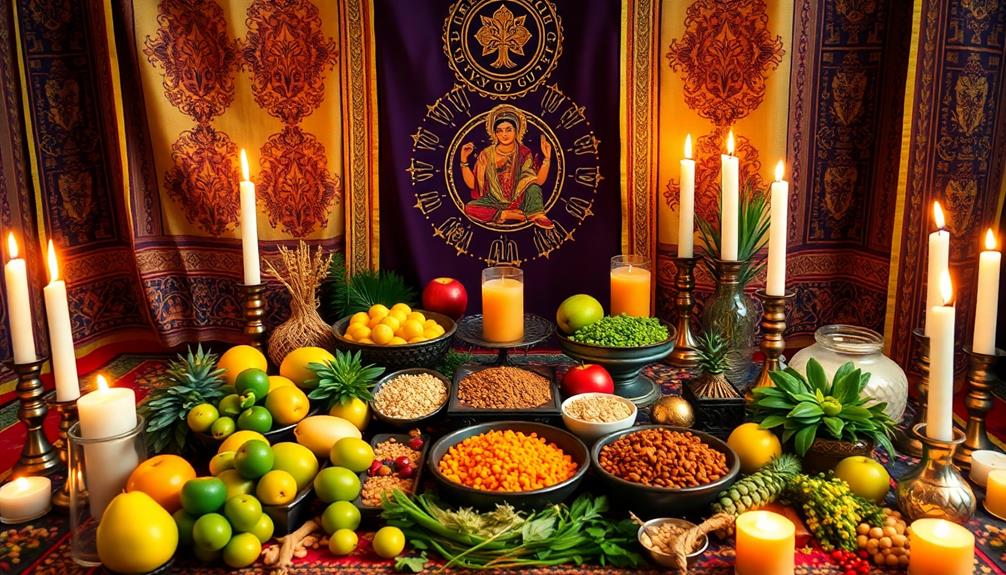
Sacred foods play an essential role in various religious practices, serving as more than just nourishment. They embody deep cultural identity and spiritual significance. For instance, in Jewish tradition, gefilte fish and matzah are integral to the Passover Seder, symbolizing heritage and the liberation from slavery. These sacred foods connect you to the past and enhance the rituals surrounding food.
In Italian cuisine, certain dishes, such as agnolotti, are often made for special occasions, reflecting regional pride and family traditions.
During Christian Communion, bread and wine symbolize the body and blood of Christ, reflecting the doctrine of Transubstantiation. This act transforms a simple meal into a profound spiritual experience. Similarly, Hindu devotees offer Prasadam during puja, sharing these blessed foods with the community, reinforcing bonds and collective identity.
In the context of Ramadan, the evening meal of Iftar symbolizes gratitude and the communal spirit that arises after a day of fasting. Each of these practices emphasizes the importance of sacred food in fostering community and enhancing spiritual connection.
Cultural Significance of Shared Meals
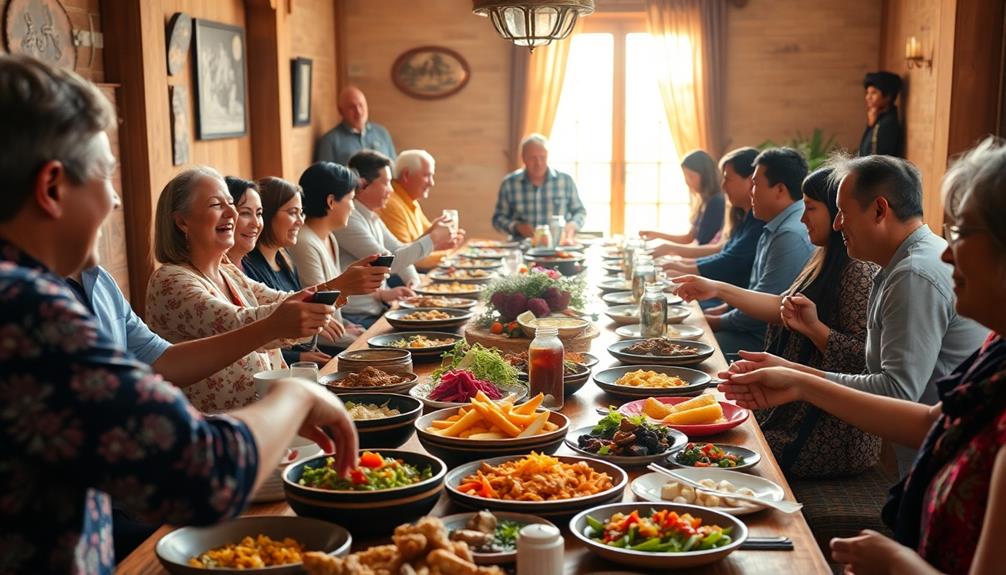
Sharing a meal brings people together, creating bonds that transcend individual differences and foster a sense of belonging. Commensality, the act of sharing meals, plays an essential role in enhancing relationships across various cultures.
When you gather around the table, whether during a Passover Seder or Iftar, you participate in rituals that symbolize community and collective remembrance, reinforcing cultural values and identities. The dishes served often reflect the richness of that culture, such as the bold flavors found in Chicken Chettinad or the sweetness of Rasgulla, which can evoke memories of family celebrations.
The food you choose and how you prepare it often reflect the traditions of your culture. These shared meals act as rituals that celebrate heritage and strengthen communal ties. Family dinners and festivals become more than just meals; they serve as platforms for storytelling, allowing you to share experiences and pass down traditions.
Symbolism and Identity in Food
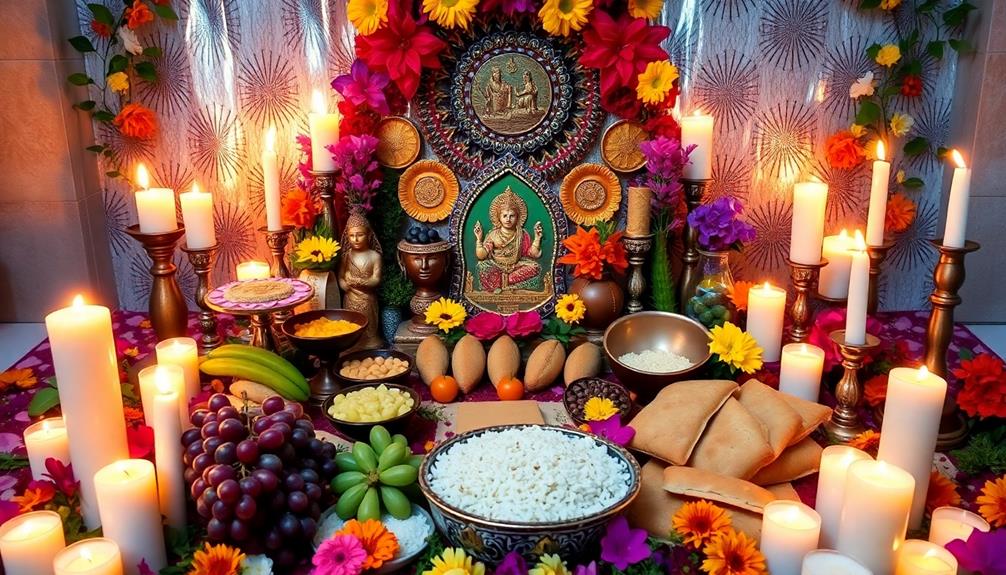
Food often embodies profound symbolism and reflects cultural identity, shaping how communities perceive themselves and their traditions. Sacred foods carry deep meanings that connect you to your heritage.
For instance, during Passover, bitter herbs symbolize suffering and remembrance in Jewish tradition, emphasizing the collective history that binds the community together. In Christianity, the Eucharist—bread and wine—represents unity with Christ and reinforces your identity as part of a larger spiritual body.
Similarly, traditional dishes like Caldeirada showcase how food can celebrate cultural roots and shared experiences. Foods like dates appear in various cultures as symbols of abundance and nourishment, further highlighting the link between food and cultural identity.
Ritualistic offerings, such as Prasadam in Hinduism, connect you with the divine while fostering community sharing and identity among devotees. These sacred foods create a sense of belonging and nostalgia, especially for diasporic communities, helping you maintain cultural identity in new environments through shared culinary traditions.
Ultimately, the symbolism embedded in these foods helps shape your understanding of self within a broader cultural context. By partaking in these sacred foods, you not only honor your traditions but also strengthen the bonds with your community.
Anthropological Perspectives on Food
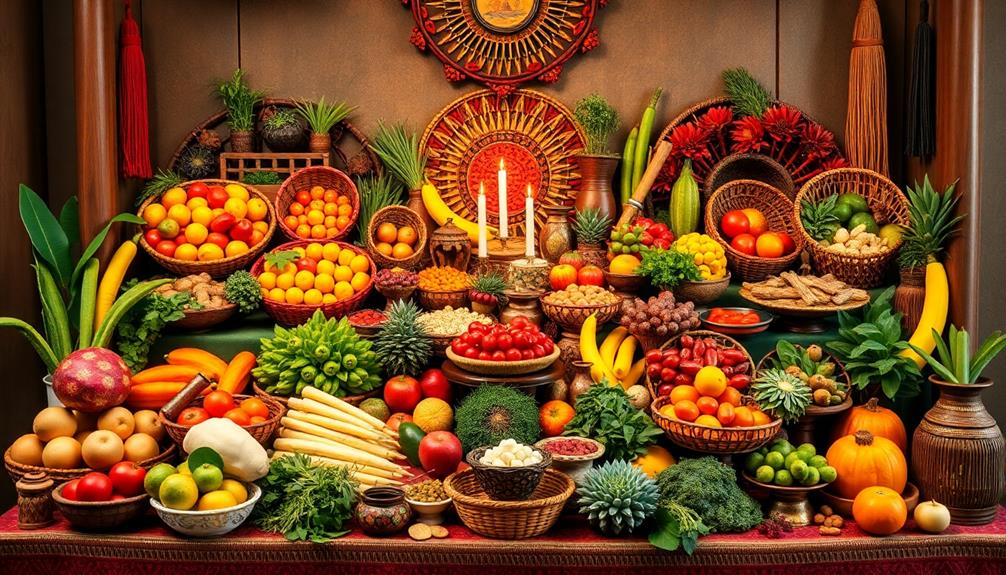
When you explore anthropological perspectives on food, you'll see how cultural significance shapes rituals and sacred practices.
For instance, dishes like Dorayaki (Red Bean Pancake) reflect not only culinary traditions but also the communal values of sharing and childhood nostalgia.
The choices people make about what to eat often reflect deep symbolic meanings tied to their beliefs and identities.
Understanding these connections can reveal much about a community's values and social structures.
Cultural Significance of Food
Throughout history and across cultures, the significance of food transcends mere sustenance, becoming a powerful symbol of identity and connection. Foods like bread often embody the essence of a community's food culture, linking generations and nurturing a sense of belonging.
Traditional Ethiopian dishes, such as Yekolo (Roasted Barley) and Tej, highlight the deep-rooted cultural significance of ingredients that reflect the agricultural richness of the land. When you partake in traditional meals, you're engaging in a ritual that honors your ancestors and reinforces social bonds.
- Sacred foods reflect cultural identity and community history.
- Commensality enhances relationships and fosters a sense of belonging.
- Spiritual nourishment is conveyed through the preparation and sharing of food.
Anthropological studies reveal that the act of sharing meals, or commensality, is crucial in expressing cultural values. The preparation and consumption of sacred foods are rich in symbolic meaning, conveying respect and gratitude.
These practices help you connect with the divine and deepen your understanding of your heritage. The significance of certain foods often ties back to historical events, imbuing them with a sacred status that resonates within your cultural identity.
Embracing these traditions not only enriches your food experience but also strengthens your connection to your community and its values.
Rituals and Sacred Practices
Rituals surrounding sacred foods often bring people together, weaving spiritual meaning into the fabric of community life. These rituals dictate specific preparation methods, enhancing the spiritual significance of what's consumed. In Judaism, kosher practices and in Hinduism, vegetarian offerings, highlight the importance of intention and respect in food preparation.
Similarly, traditional dishes like Muamba De Galinha in Angola aren't just meals but are integral to cultural gatherings, fostering a sense of belonging and shared identity among participants.
During religious ceremonies, sacred foods take on transformative roles, as seen in the Eucharist, where bread and wine symbolize the body and blood of Christ, reinforcing community ties and divine connection. Many Indigenous cultures honor nature through food offerings, showcasing a profound respect for life and interconnectedness.
They often include rituals that pay homage to the spirits of animals sacrificed for sustenance, emphasizing gratitude.
The sharing of sacred foods during observances like the Iftar meal during Ramadan fosters communal bonds, reinforcing shared beliefs and values among participants. In Brazilian Candomblé, specific foods like fish are offered to the goddess Iemanjá, illustrating the cultural significance of food in spiritual practices.
These rituals not only celebrate sacred foods but also strengthen the community, enriching the spiritual experiences of those involved.
Symbolism in Food Choices
Sacred foods carry profound symbolism that reflects cultural beliefs and societal values. When you engage with these foods, you're not just eating; you're connecting with a deeper narrative that spans generations.
For example, during Jewish Passover, bitter herbs serve as a poignant reminder of suffering and remembrance, tying individuals to their shared history. In Christianity, the Eucharist's bread and wine symbolize unity with Christ, showcasing how food is sacred in spiritual rituals.
In Indonesia, traditional dishes like Kue Putu and Nasi Tumpeng highlight the significance of food in celebrations and communal harmony.
Consider these symbolic meanings of sacred foods:
- Bitter herbs: Remind us of hardship and resilience in Jewish culture.
- Prasadam: Represents divine blessings in Hinduism, reinforcing spiritual connections.
- Dates: Signify abundance and nourishment, especially during Ramadan, emphasizing community ties.
As you navigate food choices, you'll notice how symbolic meanings shift from culture to culture. This interplay of food and meaning shapes not just individual experiences but also collective identities, illustrating how food is sacred and integral to expressing beliefs and values.
Recognizing these symbols enriches your understanding of the diverse ways people celebrate their traditions.
Historical Context of Sacred Foods
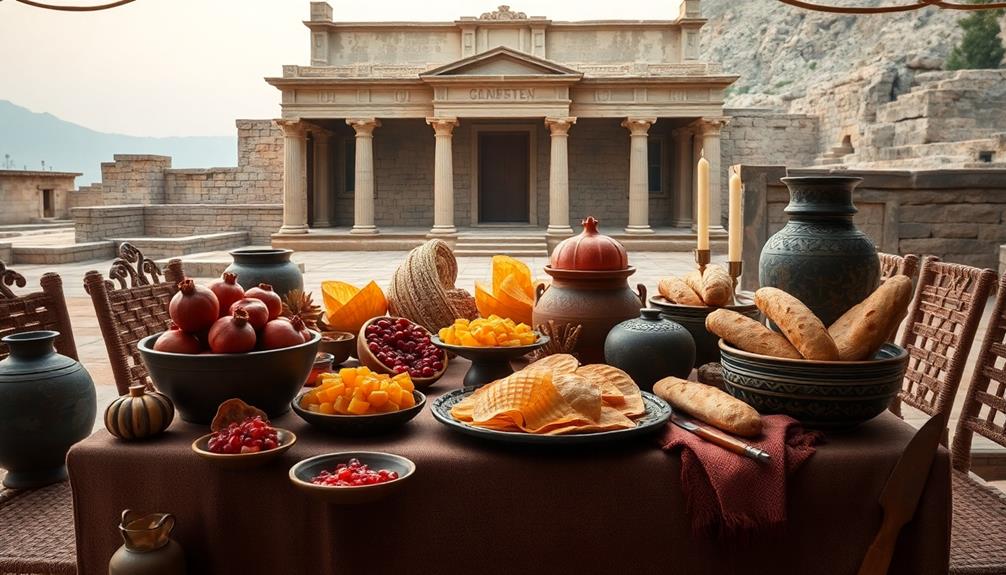
Many cultures have long designated specific foods as sacred, intertwining them with their religious beliefs and practices. These sacred foods often arise from significant historical events, rituals, or deities. For example, during the Christian Eucharist, bread and wine represent Jesus' body and blood, marking a pivotal moment in Christian faith.
In Judaism, the Passover Seder features symbolic foods like matzah and bitter herbs, commemorating the Israelites' liberation from slavery in Egypt. Similarly, in Lebanese cuisine, dishes like Kawarma serve not only as nourishment but also as a connection to cultural heritage, often prepared during festive occasions and family gatherings.
In Hinduism, prasadam—food offered to deities—serves as a means to connect spiritually with the divine during puja rituals. Indigenous cultures also regard sacred foods as important parts of their cultural identity, reflecting local ecologies and spiritual beliefs. Specific offerings align with seasonal harvests and natural events, emphasizing the interconnectedness of life.
The historical significance of these sacred foods is often documented in religious texts, reinforcing their role in maintaining cultural identity and shared practices across generations.
Food Practices and Cultural Identity
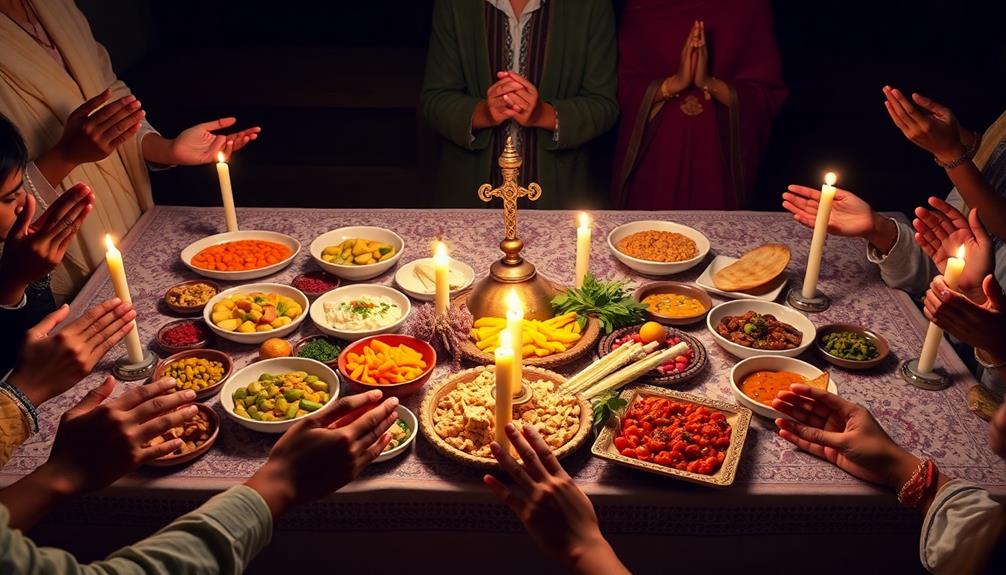
Food practices play an essential role in shaping cultural identity, as they connect people to their heritage and shared histories. The role of food goes beyond mere sustenance; it's about tradition, community, and belonging. Your food choices reflect your background and values, often closely linked to familial and cultural narratives.
For instance, festive occasions often feature unique dishes, such as Graveyard Taco Dip, which can evoke memories and foster connections during celebrations.
Consider how certain ingredients or dishes carry deep significance within communities:
- Regional Roots: Ingredients like rice in Asian cultures or corn in Indigenous American traditions tell stories of ancestral origins.
- Culinary Narratives: Recipes and rituals passed down through generations preserve cultural heritage, offering a glimpse into societal norms and history.
- Commensality: Sharing meals fosters social bonds, emphasizing respect and connection within communities.
As globalization influences culinary practices, many endeavor to maintain traditional food practices. These efforts are crucial in preserving cultural identity in an increasingly interconnected world.
Rituals Surrounding Sacred Food
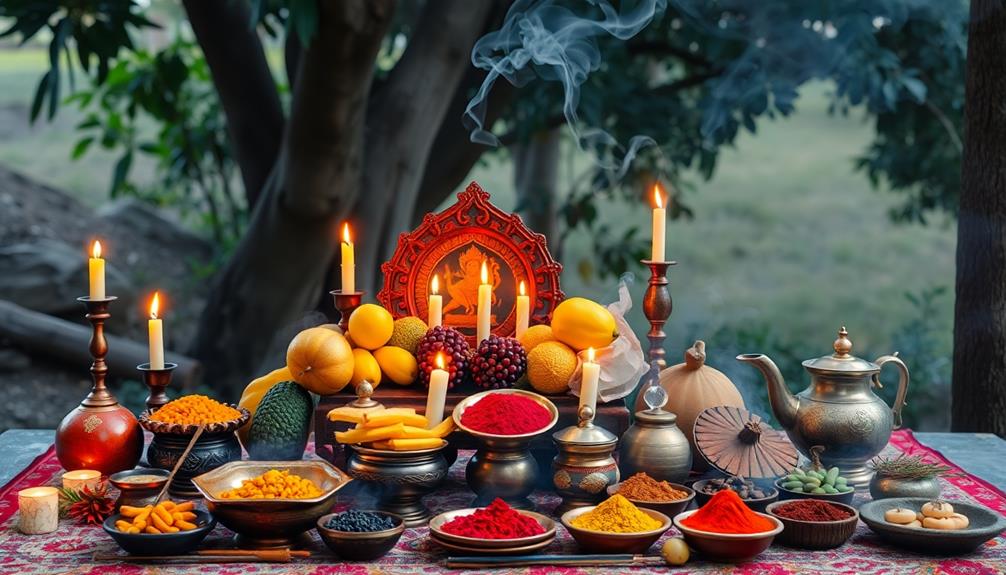
When you think about sacred food rituals, consider how historical contexts shape these practices. The preparation of offerings, like kosher slaughtering or the Eucharist, carries deep spiritual significance that connects you to your community.
For instance, the process of bleeding meat in traditional Spanish cuisine enhances flavor, reflecting the importance of ritual in food preparation. Engaging in these shared rituals not only honors traditions but also reinforces social bonds and collective identity.
Historical Context of Offerings
Throughout history, various cultures have woven food offerings into their spiritual practices, creating a profound connection between the material and the divine. In many traditions, specific foods hold symbolic meanings, enhancing rituals and deepening faith.
For example, the consumption of bread and wine in Christianity during the Eucharist signifies the body and blood of Christ, intertwining nourishment with spirituality.
Similarly, in Hinduism, offerings of fruits and sweets during puja ceremonies represent devotion, later enjoyed as Prasadam, embodying blessings for devotees.
Other traditions, like the Jewish Passover Seder, utilize specific foods such as matzah and bitter herbs to commemorate liberation and remembrance.
Consider these key points about historical offerings:
- Food plays a crucial role in connecting communities and reinforcing shared beliefs.
- Rituals often involve the symbolic consumption of food, transforming it into a sacred act.
- Offerings aren't just about sustenance; they embody gratitude, devotion, and unity.
Preparation and Ritual Significance
Many religious traditions incorporate specific rituals in the preparation of sacred foods, creating a meaningful experience that transcends mere nourishment. These rituals often include washing, blessing, or anointing the food to guarantee spiritual purification. For example, during the Jewish Passover Seder, foods like matzah and bitter herbs are prepared with prayers that highlight their symbolic significance. Similarly, in Hinduism, prasadam—food offered to deities—is shared among devotees, symbolizing divine blessings.
The table below illustrates the preparation and ritual significance of sacred foods across different traditions:
| Tradition | Ritual Significance |
|---|---|
| Judaism | Blessings and prayers during the Seder |
| Hinduism | Offering to deities and sharing as prasadam |
| Christianity | Consecration of bread and wine in the Eucharist |
In many Indigenous cultures, the preparation of sacred food connects to seasonal cycles, bringing people together in communal gatherings. These rituals not only honor the food but also reinforce the bonds between individuals and their cultural identities, highlighting the deep relationship between nourishment, spirituality, and community.
Community and Shared Practices
Rituals surrounding sacred foods play a vital role in fostering community and shared practices among participants. When you engage in these rituals, you're not just eating; you're participating in a collective experience that strengthens social bonds. Whether it's the Christian Eucharist or the Muslim Iftar during Ramadan, these moments of communal sharing enhance community cohesion and reaffirm cultural heritage.
- Sacred foods often symbolize important historical events, linking you to your ancestors and their traditions.
- Rituals like the Jewish Passover Seder emphasize communal identity, allowing you to feel a sense of belonging within your community.
- In Hindu traditions, sharing Prasadam after Puja embodies spiritual blessings and nurtures connections among devotees.
These practices often involve purification processes, ensuring that the food is spiritually prepared, which maintains the sanctity of the meal.
Festivals and gatherings centered around sacred foods not only nourish the body but also celebrate collective memory and cultural heritage. By participating in these rituals, you become part of a larger narrative that links you to your community, past and present, enriching your understanding of shared values and beliefs.
Frequently Asked Questions
What Makes Food Sacred?
Food becomes sacred when you connect it to rituals, beliefs, or communal experiences. It embodies reverence through careful preparation, shared meals, and the respect given to its origins, creating a deeper bond with your culture and spirituality.
Why Do Certain Cultures Eat Certain Foods?
Certain cultures eat specific foods due to regional availability, historical influences, and religious beliefs. These factors shape preferences and traditions, creating unique culinary identities that reflect community values and practices passed down through generations.
Why Are Traditional Foods Important to a Culture?
Traditional foods are essential to your culture because they reflect your identity, connect you to your heritage, and strengthen community bonds. They evoke nostalgia, celebrate significant events, and help preserve your unique customs for future generations.
What Do You Mean by Sacred Food?
When you think of sacred food, you're considering items that hold deep spiritual significance. They're often tied to rituals, symbolize beliefs, and create a sense of community, connecting you to your culture and traditions.
Conclusion
As you sit at the communal table, each dish tells a story—like threads woven into a tapestry of tradition. These sacred foods, much like whispered secrets, bind you to the past and connect you to your community. They're not just nourishment; they're vessels of identity, carrying the weight of rituals and memories. In sharing these meals, you partake in a timeless dance, honoring the sacredness that sustains both body and spirit, reminding you of your place in the grand narrative of life.
